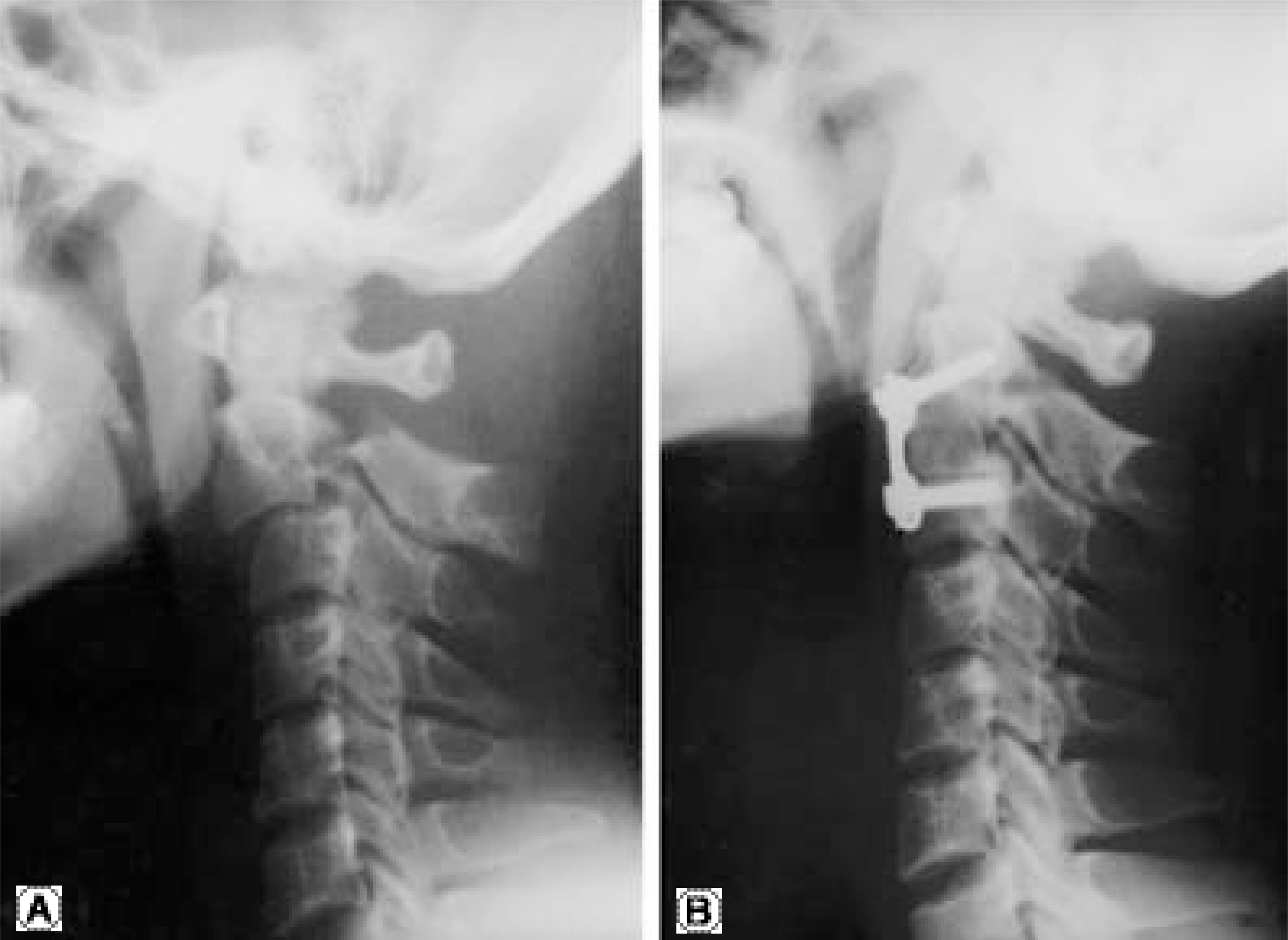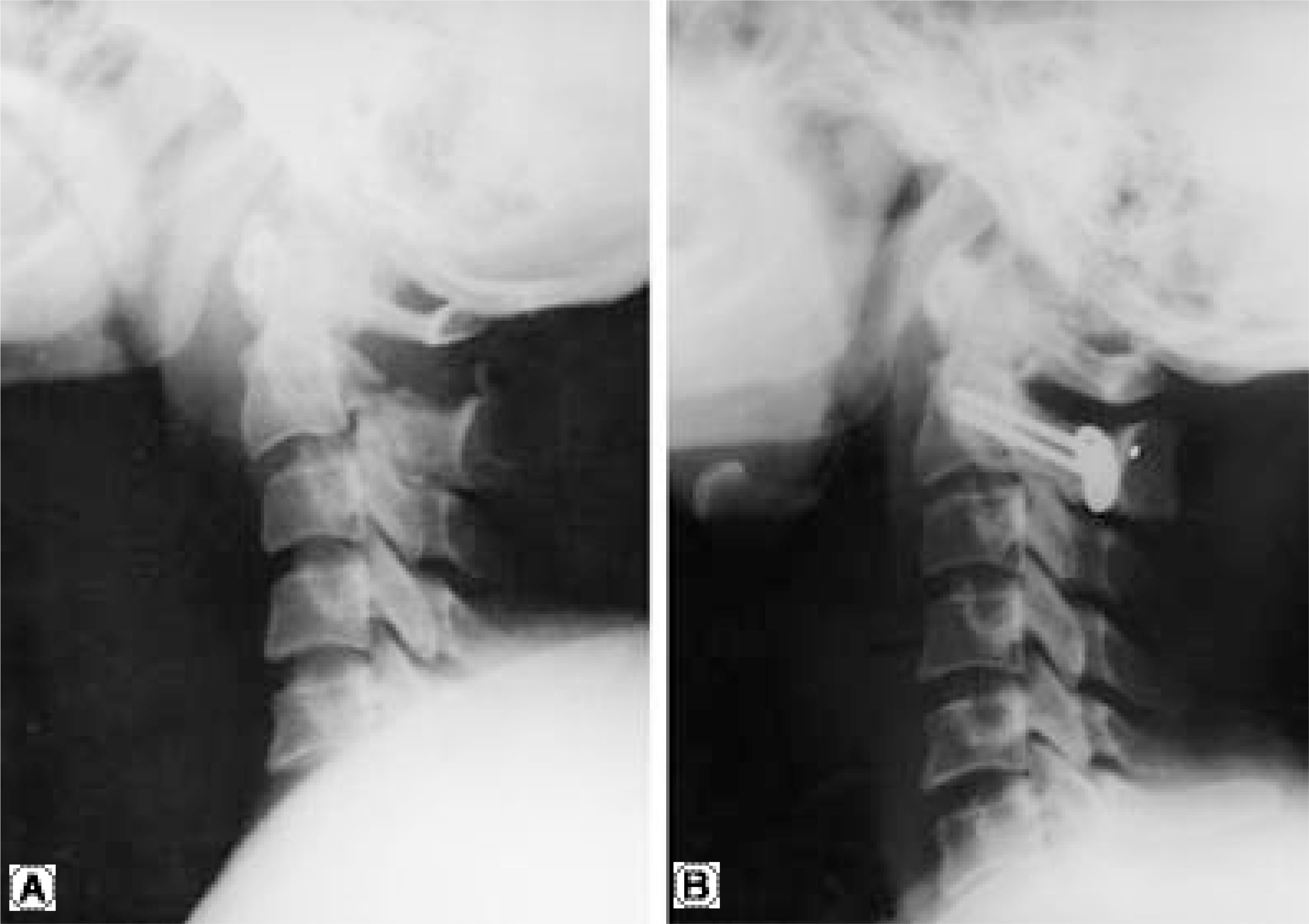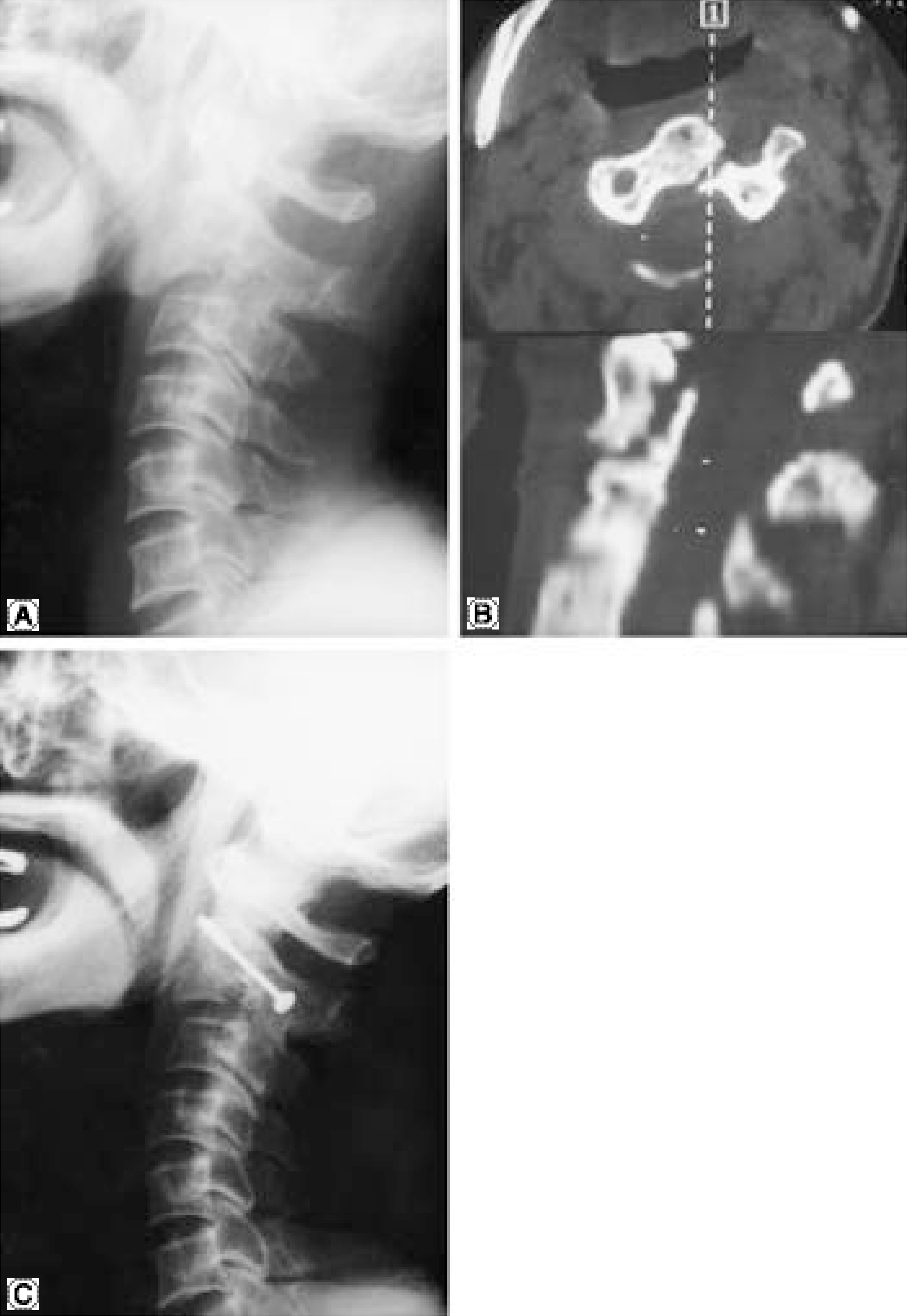J Korean Soc Spine Surg.
2002 Dec;9(4):296-304. 10.4184/jkss.2002.9.4.296.
Operative Treatment for Hangman Fracture of the Axis: Review of Fixation Methods and Indications
- Affiliations
-
- 1Department of Orthopaedics, Chonnam National University Hospital, Gwangju, Korea. jychung@chonnam.ac.kr
- KMID: 2209711
- DOI: http://doi.org/10.4184/jkss.2002.9.4.296
Abstract
OBJECTIVES
To evaluate the surgical indications and to compare the results of the anterior plate fixation and transpedicular fixation in cases of traumatic spondylolisthesis of the axis.
MATERIALS AND METHODS
From 1987 to 2001, eighteen of 26 cases of traumatic spondylolisthesis of the axis were treated by anterior plate fixation and 8 of 26 by transpedicular screw fixation. Two of 8 cases received unilateral screw fixation and 6bilateral fixation. Two cases of the transpedicular screw fixation group were treated by additional posterior plate fixation. Oper-ativeindication was an unstable fracture, namely, with over 3.5 mm of anterior displacement, over 10 degrees of angulation, i.e., Levine types II, IIA, III, and IA. Postoperatively, Philadelphia orthosis or a soft collar was applied for 6 to 8 weeks.
RESULTS
All cases achieved bone union. One case of neck pain, three cases of neck motion limitation and three cases of a kyphotic deformity exceeding 10degrees were observed in the posterior transpedicular screw fixation group. In terms of surgical complications, two cases of transient dysphagia were observed in the anterior plate fixation group and two cases of screw malposition in the transpedicular screw fixation group. The transpedicular screw fixation technique has some associated problems, such as a large operative wound scar, a large bleeding volume, and technical difficulty.
CONCLUSION
Both the anterior plate fixation and transpedicular screw fixation methods are useful treatment methods for Levine type II, IIA and III hangman fracture for early bone union and early rehabilitation. The anterior plate fixation technique is easi-er and has fewer complications than posterior transpedicular screw fixation, therefore, the ranspedicular screw fixation method should be confined to the management of type IA fracture with rotational displacement.
Keyword
MeSH Terms
Figure
Reference
-
1). Borne GM, Bedou GL and Pinaudeau M. Treatment of Pedicular Fracture of the Axis. A Clinical Study and Screw Fixation Technique. J Neurosurg. 60:88–93. 1984.2). Brashear HR, Venters GC and Preston ET. Fractures of the Neural Arch of the Axis. A Report of Twenty-nine Cases. J Bone Joint Surg. 57A:879–887. 1975.
Article3). Caspar W. Anterior Stabilization with the Trapezial Osteosynthetic Plate Technique in Cervical Spine Injuries. Cervical Spine I. Kehr P, Weidner A, editors. p. 198–204. Springer-Verlag, Wien;1985.
Article4). Chung JY, Shin HC, Kim HS. Anterior plate fixation of the fracture-dislocation of cervical spine. J of Korean Orthop Assoc. 23:1541–1548. 1988.5). Chung JY, Song YJ, Choi BY. The results of the operative treatment for the traumatic spondylolisthesis of axis -Anterior plate fixation and transpedicular screw fixation. J of Korean Orthop Assoc. 29:965–971. 1994.
Article6). Cornish BL. Traumatic Spondylolisthesis of the Axis. J Bone Joint Surg. 50B:31–43. 1968.
Article7). Effendi B, Roy D, Cornish B, Dussault RG and Laurin CA. Fracture of the Ring of the Axis-A Classification Based on the Analysis of 131 Cases. J Bone Joint Surg. 63B:319–329. 1981.8). Fielding JW, Franicis WR, Hawkins RJ, Pepin J and Hensinger R. Traumatic Spondylolisthesis of the Axis. Clin Orthop. 239:47–52. 1989.
Article9). Francis WR, Fielding JW, Hawkins RJ, Pepin J and Hensinger R. Traumatic Spondylolisthesis of the Axis. J Bone Joint Surg. 63B:313–318. 1981.
Article10). Frankel HL, Hancock DO, Ungar GH, Melzak J, Michaelis LS, Ungar GJ, Vernon JDS and Walsh JJ. The Value of Postural Reduction in the Initial Management of Closed Injuries of the Spine with Paraplegia and Tetraplegia. Paraplegia. 6:179–192. 1969.
Article11). Garber JN. Abnormalities of the Atlas and Axis Vertebrae. Congenital and Traumatic. J Bone Joint Surg. 46A:1782–1791. 1964.12). Hadley MN, Sonntag VKH, Grahm TW, Masferrer R and Browner C. Axis Fractures Resulting from Motor Vehicle Accidents. The Need for Occupant Restraints. Spine. 11:861–864. 1986.13). Levine AM and Edward CC. The Management of Traumatic Spondylolisthesis of the Axis. J Bone Joint Surg. 67-A:217–226. 1985.14). Lifeso RM, Colucci MA. Anterior fusion for rotationally unstable cervical spine fractures. Spine. 25(16):2028–2034. 2000.
Article15). Moon MS, Ok IY, Song SW, Kim HG. Traumatic spondylolisthesis of the aixs. J of Korean Orthop Assoc. 21:1126–1131. 1986.16). Marar BC. Fracture of the Axis. Clin Orthop. 106:155–165. 1975.17). Norrell H, Wilson CB. Early anterior fusion for injuryies of the cervical portion of the spine. JAMA 19:. 214(3):525–530. 1970.18). Roy-Camille R, Saillant G and Mazel C. Internal Fixation of Unstable Cervical Spine by a Posterior Osteosyn -thesis with Plates and Screw. the Cervical Spine. Sherk H, editor. 2nd Ed.p. 390–403. JB Lippincott Co.;Philadelphia: 1989.19). Schneider RC, Livingston KE, Cave AJE and Hamil-ton G. “ Hangman’s Fracture” of Cervical Spine. J Neurosurg. 22:141–154. 1965.20). Southwick WO and Robinson RA. Surgical Approaches to the Vertebral Bodies in the Cervical and Lumbar Region. J Bone Joint Surg. 39A:631. 1957.21). Tuite GF, Papadopoulos MD, Sonntag VK. Ca sper plate fixation for the treatment of complex hangman's fractures. Neurosurgery. 30:761–765. 1992.22). Wilson AJ, Marshall RW and Ewart M. Tra nsor al fusion with internal fixation in a displaced hangman’s fracture. Spine. 24(3):295–298. 1999.23). Wood-Jones F. The Ideal Lesion Produced by Judicial Hangman. Lancet. 1:53. 1913.
- Full Text Links
- Actions
-
Cited
- CITED
-
- Close
- Share
- Similar articles
-
- Direct Reduction and Fixation for Unstable Hangman's Fracture with Posterior Lateral Mass Plating: Report of 4 Cases
- C1-C3 Lateral Mass Screw-Rod Fixation and Fusion for C2 Pathologies and Hangman's Fractures
- Clinical Review of the Isolated Acute Axis Fracture
- Posterior Short Segment Fixation and Fusion in a Displaced Hangman's Fracture
- The results of the Operative Treatment for the Traumatic Spondylolisthesis of Axis: Anterior plate fixation and transpedicular screw fixation






